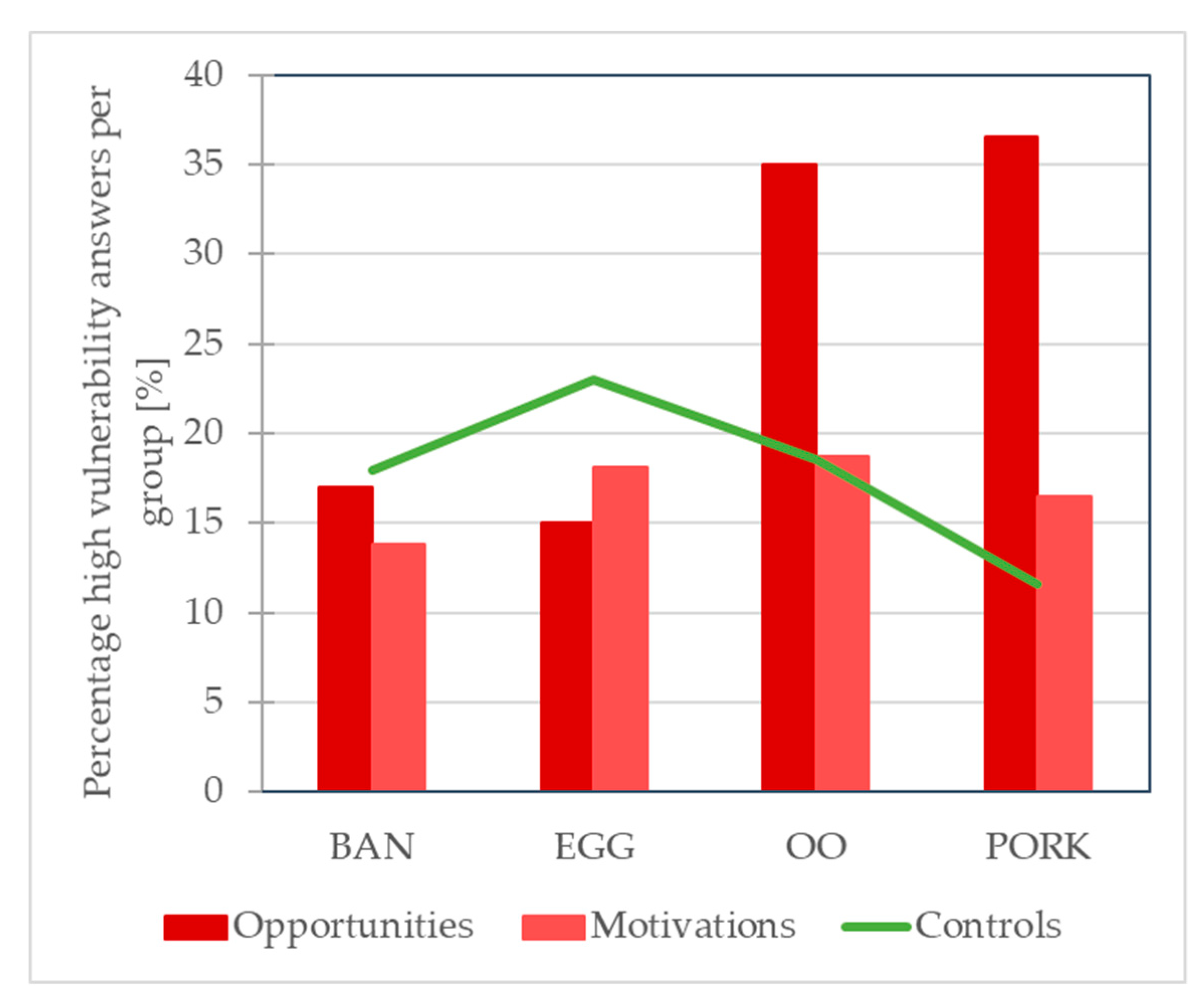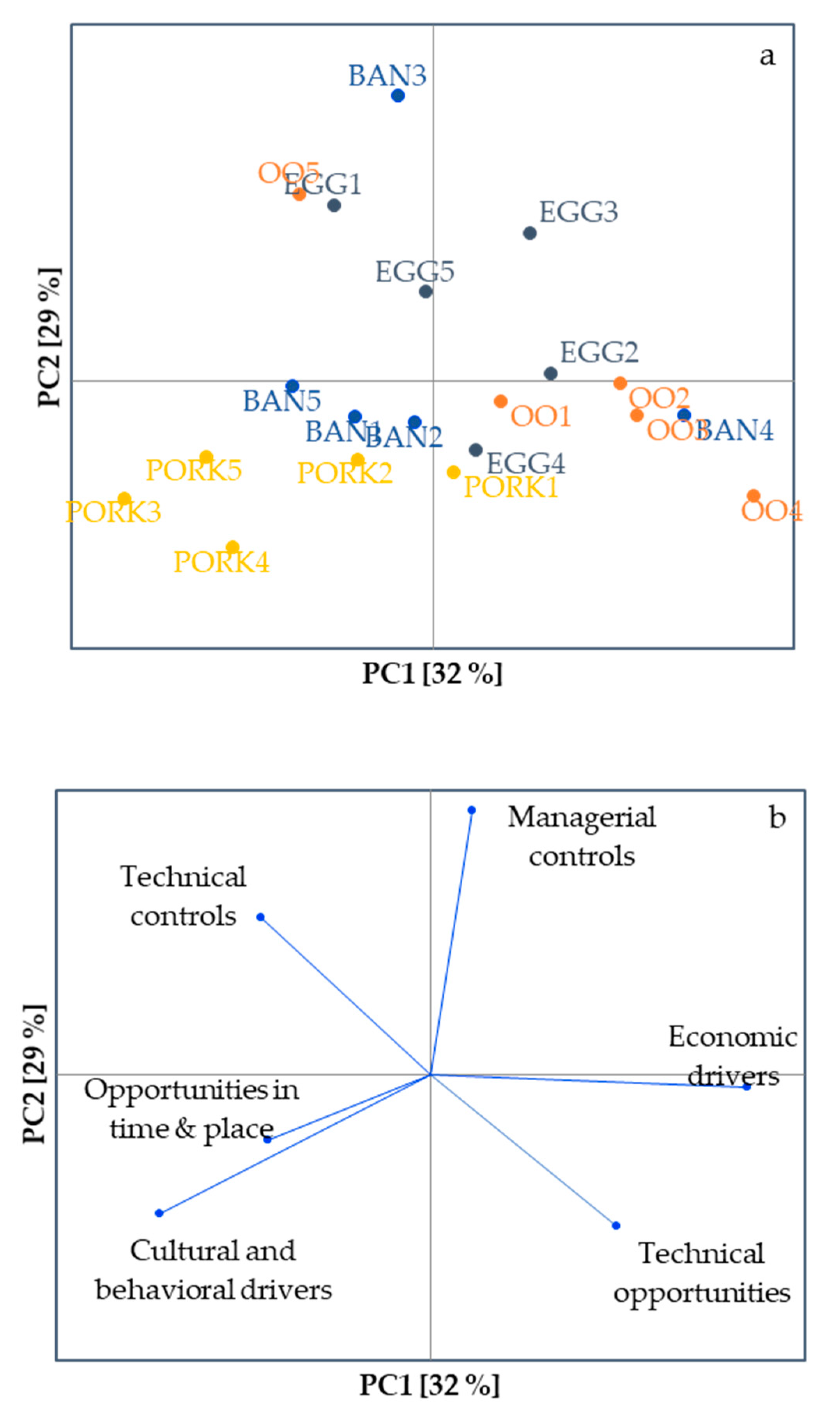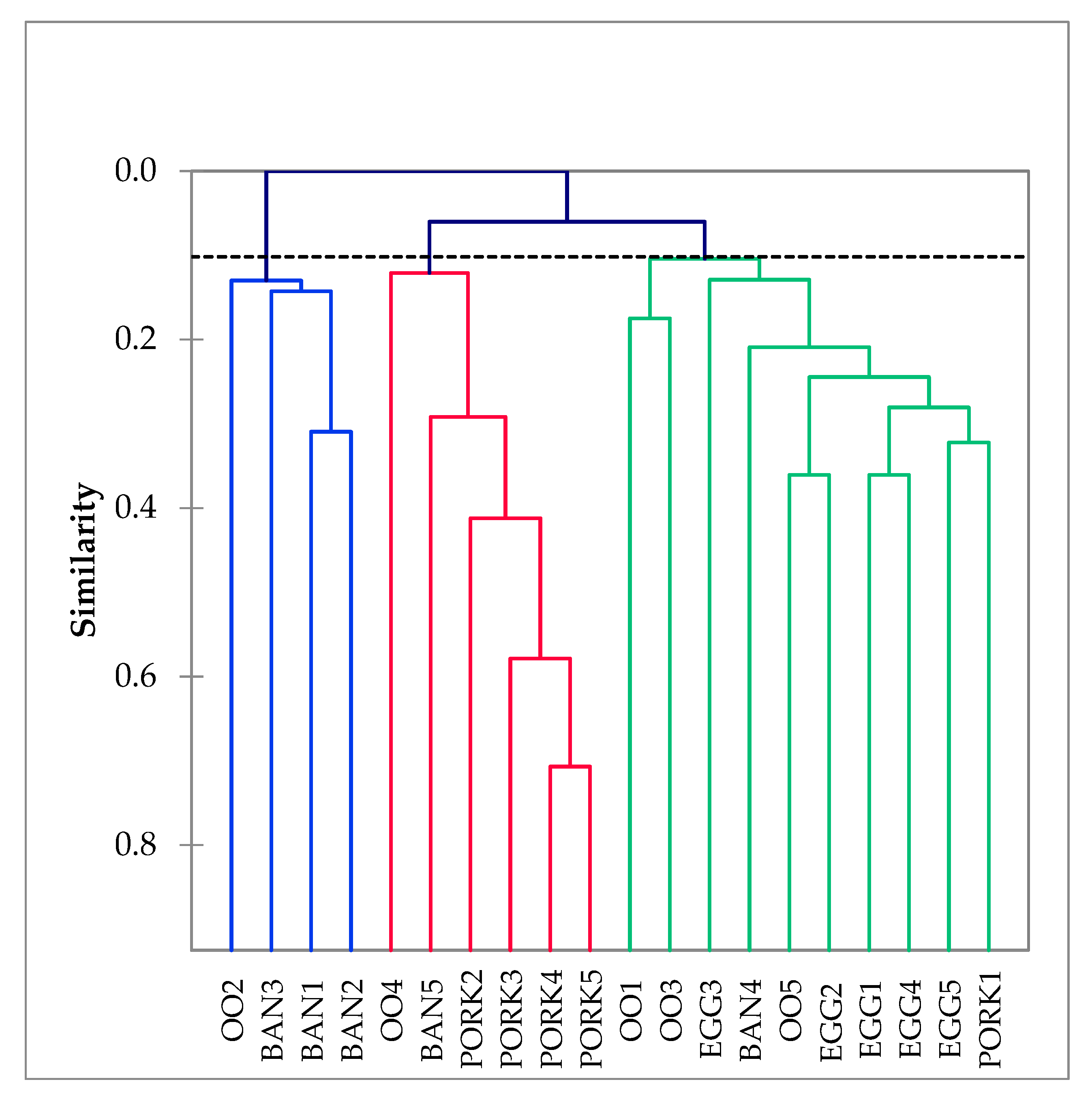Integrity of Organic Foods and Their Suppliers: Fraud Vulnerability Across Chains
Abstract
1. Introduction
2. Materials and Methods
2.1. Respondents
2.2. FFVA
2.3. Data Analysis
3. Results and Discussion
3.1. Vulnerability Differences Among Organic Chains and Comparison with Conventional Chains
3.2. Vulnerability Differences Among Organic Chain Actors Due to Cultural and Behavioral Drivers
4. Conclusions
Author Contributions
Funding
Acknowledgments
Conflicts of Interest
Appendix A
| Opportunities | |
| Technical Opportunities | Opportunities in Time and Place |
| Q1. Complexity of adulteration raw materials | Q8. Access to production lines/processing activities |
| Q2. Availability of technology and knowledge to adulterate raw materials | Q9. Transparency in the chain network |
| Q3. Fraud detectability in raw materials | Q10. Historical evidence of fraud in raw materials |
| Q4. Availability of technology and knowledge to adulterate final products | Q11. Historical evidence of fraud in final products |
| Q5. Fraud detectability in final products | |
| Motivations | |
| Economic Drivers | Cultural and Behavioral Drivers |
| Q12. Supply and pricing raw materials | Q15. Organizational strategy of own company |
| Q13. Valuable components or attributes | Q16. Ethical business culture of own company |
| Q14. Economic health of own company | Q17. Criminal offences of own company |
| Q20. Economic health of supplier | Q18. Corruption level country of own company |
| Q26. Economic health of sector | Q19. Financial strains imposed on supplier by own company |
| Q30. Level of competition branch of industry | Q21. Organizational strategy of supplier |
| Q31. Price asymmetries | Q22. Ethical business culture of supplier |
| Q23. Criminal offences of supplier | |
| Q24. Victimization of supplier | |
| Q25. Corruption level country of suppliers | |
| Q27. Criminal offences of customer | |
| Q28. Ethical business culture of branch of industry | |
| Q29. Historical evidence in branch of industry | |
| Controls | |
| Technical Controls | Managerial Controls |
| Q32. Fraud monitoring system for raw materials of own company | Q38. Integrity screening of own employees |
| Q33. Verification of fraud monitoring system for raw materials of own company | Q39. Ethical code of conduct of own company |
| Q34. Fraud monitoring system for final products of own company | Q40. Whistle-blowing facilities of own company |
| Q35. Verification of fraud monitoring system for final products of own company | Q41. Contractual requirements of supplier |
| Q36. Information system of own company | Q45. Social control in chain network |
| Q37. Tracking and tracing system of own company | Q47. National food policy |
| Q42. Fraud monitoring system of supplier | Q48. Law enforcement in local chain |
| Q43. Information system of supplier | Q49. Law enforcement in chain network |
| Q44. Tracking and tracing system of supplier | |
| Q46. Fraud control in sector | |
| Q50. Contingency plan | |
References
- Kushwah, S.; Dhir, A.; Sagar, M.; Gupta, B. Determinants of organic food consumption. A systematic literature review on motives and barriers. Appetite 2019, 143, 104402. [Google Scholar] [CrossRef] [PubMed]
- Popa, M.E.; Mitelut, A.C.; Popa, E.E.; Stan, A.; Popa, V.I. Organic foods contribution to nutritional quality and value. Trends Food Sci. Technol. 2019, 84, 15–18. [Google Scholar] [CrossRef]
- Tuomisto, H.L.; Hodge, I.D.; Riordan, P.; Macdonald, D.W. Does organic farming reduce environmental impacts?—A meta-analysis of European research. J. Environ. Manag. 2012, 112, 309–320. [Google Scholar] [CrossRef] [PubMed]
- Suciu, N.A.; Ferrari, F.; Trevisan, M. Organic and conventional food: Comparison and future research. Trends Food Sci. Technol. 2019, 84, 49–51. [Google Scholar] [CrossRef]
- Peng, M. The growing market of organic foods: Impact on the US and global economy. In Safety and Practice of Organic Food; Biswas, D., Micallef, S.A., Eds.; Volume Organic Food Products, Diverse Production Practices, and Policies; Academic Press: Cambridge, MA, USA, 2019; pp. 3–22. [Google Scholar]
- Codex Standard GL 32-1999. Guidelines for the Production, Processing, Labelling and Marketing of Organically Produced Foods; Codex Alimentarius: Rome, Italy, 1999; Available online: http://www.fao.org/3/a1385e/a1385e00.htm (accessed on 8 January 2020).
- IFOAM. The IFOAM Norms for Organic Production and Processing, Version 2014; IFOAM: Bonn, Germany, 2014; Available online: https://www.ifoam.bio/sites/default/files/ifoam_norms_july_2014_t.pdf (accessed on 8 January 2020).
- Council Regulation (EC) No 834/2007. Council Regulation (EC) No 834/2007 of 28 June 2007 on Organic Production and Labelling of Organic Products and Repealing Regulation (EEC) No 2092/91; European Commission: Brussels, Belgium, 2007; Available online: https://eur-lex.europa.eu/legal-content/EN/TXT/?uri=celex%3A32007R0834 (accessed on 8 January 2020).
- Head of America’s Largest Organic Food Fraud Scheme Sentenced to 10 Years. Available online: https://globalnews.ca/news/5778147/organic-food-fraud-scheme/ (accessed on 8 January 2020).
- van Ruth, S.M.; Huisman, W.; Luning, P.A. Food fraud vulnerability and its key factors. Trends Food Sci. Technol. 2017, 67, 70–75. [Google Scholar] [CrossRef]
- SSAFE Food Fraud Vulnerability Assessment Tool. Available online: http://www.ssafe-food.org/ (accessed on 8 January 2020).
- Silvis, I.C.J.; van Ruth, S.M.; van der Fels-Klerx, H.J.; Luning, P.A. Assessment of food fraud vulnerability in the spices chain: An explorative study. Food Control 2017, 81, 80–87. [Google Scholar] [CrossRef]
- van Ruth, S.M.; Luning, P.A.; Silvis, I.C.J.; Yang, Y.; Huisman, W. Differences in fraud vulnerability in various food supply chains and their tiers. Food Control 2018, 84, 375–381. [Google Scholar] [CrossRef]
- Weesepoel, Y.J.A.; van Ruth, S.M. Inventarisatie van Voedselfraude: Mondiaal Kwetsbare Productgroepen en Ontwikkeling van Analytische Methoden in Europees Onderzoek; RIKILT Report 2015.014; RIKILT Wageningen UR: Wageningen, The Netherlands, 2015; p. 15. [Google Scholar]
- Murphy, P.R.; Free, C. Broadening the fraud triangle: Instrumental climate and fraud. Behav. Res. Account. 2016, 28, 41–56. [Google Scholar] [CrossRef]
- Dorminey, J.; Fleming, A.S.; Kranacher, M.J.; Riley, R.A. Beyond the fraud triangle: Enhancing deterrence of economic crimes. CPA J. 2010, 80, 17–23. [Google Scholar]
- Suh, J.B.; Shim, H.S.; Button, M. Exploring the impact of organizational investment on occupational fraud: Mediating effects of ethical culture and monitoring control. Int. J. Law Crime Justice 2018, 53, 46–55. [Google Scholar] [CrossRef]
- Schwarz, M.S. Developing and sustaining an ethical corporate culture: The core elements. Bus. Horiz. 2013, 56, 39–50. [Google Scholar] [CrossRef]
- Lyman, M.D.; Potter, G.W. Organized Crime, 4th ed.; Pearson Education, Inc.: London, UK, 2007; pp. 60–61. [Google Scholar]
- Lord, N.; Spencer, J.; Albanese, J. In pursuit of food system integrity: The situational prevention of food fraud enterprise. Eur. J. Crim. Policy Res. 2017, 23, 483–501. [Google Scholar] [CrossRef]



| Actor | Opportunities | Motivations | Controls |
|---|---|---|---|
| BAN1 | 10 | 4 | 5 |
| BAN2 | 20 | 4 | 6 |
| BAN3 | 0 | 7 | 49 |
| BAN4 | 30 | 32 | 13 |
| BAN5 | 25 | 22 | 17 |
| EGG1 | 0 | 11 | 37 |
| EGG2 | 20 | 29 | 19 |
| EGG3 | 23 | 21 | 34 |
| EGG4 | 33 | 18 | 6 |
| EGG5 | 0 | 11 | 19 |
| OO1 | 10 | 18 | 6 |
| OO2 | 30 | 14 | 13 |
| OO3 | 63 | 21 | 22 |
| OO4 | 40 | 29 | 0 |
| OO5 | 33 | 11 | 52 |
| PORK1 | 43 | 18 | 9 |
| PORK2 | 53 | 15 | 20 |
| PORK3 | 45 | 12 | 14 |
| PORK4 | 33 | 23 | 5 |
| PORK5 | 10 | 15 | 11 |
| Actor. | Ethical Business Culture Own Company | Ethical Business Culture Supplier | Ethical Business Culture Branch of Industry | Criminal Offences Own Company | Criminal Offences Supplier | Historical Evidence Branch of Industry |
|---|---|---|---|---|---|---|
| BAN1 | 1 | 1 | 1 | 1 | 1 | 1 |
| BAN2 | 1 | 1 | 1 | 1 | 1 | 1 |
| BAN3 | 1 | 1 | 1 | 1 | 1 | 1 |
| BAN4 | 1 | 1 | 1 | 1 | 1 | 3 |
| BAN5 | 1 | 2 | 2 | 1 | 2 | 3 |
| EGG1 | 1 | 2 | 3 | 1 | 2 | 2 |
| EGG2 | 1 | 1 | 2 | 1 | 1 | 1 |
| EGG3 | 1 | 2 | 2 | 1 | 2 | 2 |
| EGG4 | 1 | 1 | 1 | 1 | 1 | 2 |
| EGG5 | 1 | 2 | 3 | 1 | 1 | 2 |
| OO1 | 1 | 1 | 2 | 1 | 1 | 3 |
| OO2 | 1 | 2 | 3 | 2 | 1 | 3 |
| OO3 | 1 | 2 | 1 | 2 | 1 | 2 |
| OO4 | 1 | 2 | 2 | 1 | 1 | 3 |
| OO5 | 1 | 1 | 2 | 2 | 1 | 3 |
| PORK1 | 1 | 1 | 2 | 1 | 1 | 3 |
| PORK2 | 1 | 1 | 1 | 1 | 1 | 3 |
| PORK3 | 1 | 1 | 1 | 1 | 3 | 3 |
| PORK4 | 1 | 1 | 1 | 1 | 3 | 1 |
| PORK5 | 1 | 1 | 1 | 1 | 3 | 3 |
© 2020 by the authors. Licensee MDPI, Basel, Switzerland. This article is an open access article distributed under the terms and conditions of the Creative Commons Attribution (CC BY) license (http://creativecommons.org/licenses/by/4.0/).
Share and Cite
van Ruth, S.M.; de Pagter-de Witte, L. Integrity of Organic Foods and Their Suppliers: Fraud Vulnerability Across Chains. Foods 2020, 9, 188. https://doi.org/10.3390/foods9020188
van Ruth SM, de Pagter-de Witte L. Integrity of Organic Foods and Their Suppliers: Fraud Vulnerability Across Chains. Foods. 2020; 9(2):188. https://doi.org/10.3390/foods9020188
Chicago/Turabian Stylevan Ruth, Saskia M., and Leontien de Pagter-de Witte. 2020. "Integrity of Organic Foods and Their Suppliers: Fraud Vulnerability Across Chains" Foods 9, no. 2: 188. https://doi.org/10.3390/foods9020188
APA Stylevan Ruth, S. M., & de Pagter-de Witte, L. (2020). Integrity of Organic Foods and Their Suppliers: Fraud Vulnerability Across Chains. Foods, 9(2), 188. https://doi.org/10.3390/foods9020188




